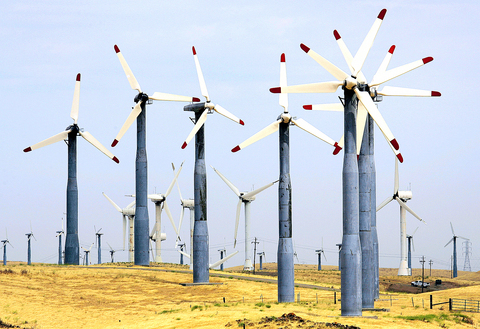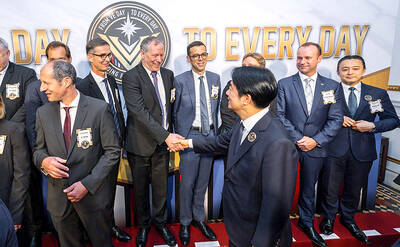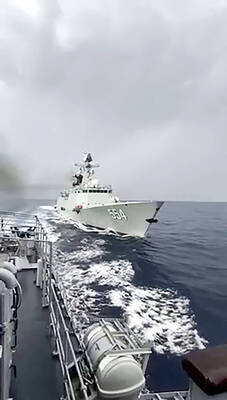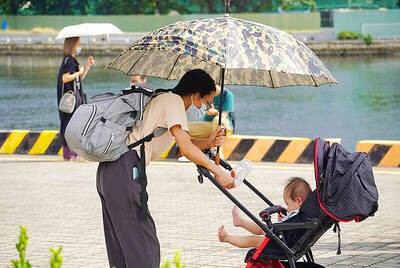When Suzlon Energy Ltd officials were looking for a place to build turbine parts for the booming US wind energy market, they could see as far as the flat horizon here allows.
With Minnesota among the top five US states in wind energy generation, and primed to double its capacity by 2010, the company is setting up its first US plant in this windswept farm town.
"With green energy the way it is, and the huge US market, we can see 100 years of life for our plant," said Jim Streiff, a vice president for Suzlon Rotor, the subsidiary that will run the Pipestone facility.

PHOTO: AP
By the end of this year, Suzlon Energy hopes to make the leap to third place in turbine sales in the US, up from fifth last year. GE Energy, based in Atlanta, Georgia, is the US' biggest domestic seller of wind turbines.
The company reported worldwide sales of US$830 million for the year ended March 31. In the US, Suzlon commissioned 80 turbines over the past year and hopes to sell more than 200 over the next year. All of their turbines are being sold to local investors and farmers, who pay between US$1 million and US$2 million for each.
A mix of federal and tax incentives, not to mention high fuel prices, are drawing local investors into the wind market. The federal government, for instance, offers a US$0.019-per-killowatt hour tax credit; in Minnesota, the state offers another US$0.015 credit. Small investors in Minnesota can negotiate with utility companies for further production credits.
According to the Minnesota Department of Employment and Economic Development, one or two turbines can generate profits of US$100,000 per year, once the capital expenditures are paid off.
Last fall, Suzlon Rotor broke ground on a US$14 million plant the size of two-and-a-half football fields on the edge of Pipestone. The plant will employ 275 people and churn out its first rotor in October. The rotor comprises the three blades of a turbine, the nose cone and the mechanics inside the cone.
Suzlon Energy already makes the rotors in India. But the high cost of shipping the parts and the chance to get in on the ground floor in the US market -- where just 1 percent of the electricity comes from wind energy -- proved enticing.
GE Energy, Spain-based Gamesa Eolica and Clipper Windpower of Carpinteria, California, are among the other turbine makers hoping to capitalize on the growing US market. Clipper opened a plant in Cedar Rapids, Iowa, several months ago.
"What we are seeing is more investment among manufacturers in opening plants, and that is a reflection of the speed of the North American market," said Christine Real de Azua, a spokeswoman for the American Wind Energy Association.
Among the new power plants that came on line last year, wind power was second after new natural gas, she said.
Beyond Minnesota, a number of other states beckon. California has the most installed capacity, followed by Texas, Iowa and Minnesota, according to the American Wind Energy Association.
In Minnesota, there is currently enough capacity to generate about 750 megawatts of wind energy. The legislature and Governor Tim Pawlenty have set a goal of 800 new megawatts of community-based wind energy by 2010.

DEFENDING DEMOCRACY: Taiwan shares the same values as those that fought in WWII, and nations must unite to halt the expansion of a new authoritarian bloc, Lai said The government yesterday held a commemoration ceremony for Victory in Europe (V-E) Day, joining the rest of the world for the first time to mark the anniversary of the end of World War II in Europe. Taiwan honoring V-E Day signifies “our growing connections with the international community,” President William Lai (賴清德) said at a reception in Taipei on the 80th anniversary of V-E Day. One of the major lessons of World War II is that “authoritarianism and aggression lead only to slaughter, tragedy and greater inequality,” Lai said. Even more importantly, the war also taught people that “those who cherish peace cannot

STEADFAST FRIEND: The bills encourage increased Taiwan-US engagement and address China’s distortion of UN Resolution 2758 to isolate Taiwan internationally The Presidential Office yesterday thanked the US House of Representatives for unanimously passing two Taiwan-related bills highlighting its solid support for Taiwan’s democracy and global participation, and for deepening bilateral relations. One of the bills, the Taiwan Assurance Implementation Act, requires the US Department of State to periodically review its guidelines for engagement with Taiwan, and report to the US Congress on the guidelines and plans to lift self-imposed limitations on US-Taiwan engagement. The other bill is the Taiwan International Solidarity Act, which clarifies that UN Resolution 2758 does not address the issue of the representation of Taiwan or its people in

The Philippines yesterday criticized a “high-risk” maneuver by a Chinese vessel near the disputed Scarborough Shoal (Huangyan Island, 黃岩島) in a rare incident involving warships from the two navies. The Scarborough Shoal — a triangular chain of reefs and rocks in the contested South China Sea — has been a flash point between the countries since China seized it from the Philippines in 2012. Taiwan also claims the shoal. Monday’s encounter took place approximately 11.8 nautical miles (22km) southeast” of the Scarborough Shoal, the Philippine military said, during ongoing US-Philippine military exercises that Beijing has criticized as destabilizing. “The Chinese frigate BN 554 was

The number of births in Taiwan fell to an all-time monthly low last month, while the population declined for the 16th consecutive month, Ministry of the Interior data released on Friday showed. The number of newborns totaled 8,684, which is 704 births fewer than in March and the lowest monthly figure on record, the ministry said. That is equivalent to roughly one baby born every five minutes and an annual crude birthrate of 4.52 per 1,000 people, the ministry added. Meanwhile, 17,205 deaths were recorded, resulting in a natural population decrease of 8,521, the data showed. More people are also leaving Taiwan, with net